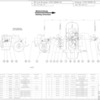I have been asked to investigate "roll chatter" on a "skin pass" steel rolling mill used for final cold rolling of previously hot rolled, 1 mm thick material for car bodies.
The mill has 2 work roll sizes (450 mm dia for 150 tons and 650 mm for 400 tons) and 2 backup rolls both 1100 mm dia.
Each work roll has a gearbox and 750 KW motor driving it.
3rd and 5th octave type chatter is documented and is speed sensitive.
This chatter problem occurs at all speeds and was not noticed at commissioning but after 2 years it has grown to a quality control problem easily visible but difficult to measure.
The backup rolls show chatter marks with a pitch of 15 to 25 mm at the end of a 30,000 ton run but there are no marks on the work rolls at this time.
The severity of the marks increases with speed.
Roll grinding is said to be good and the chatter problem is there from the start of a new roll set.
The work roll drive shafts are universal joints but the marks occur vastly more often than 2x work roll speed.
Any thoughts, anyone.
Cheers
John
Attachments
Original Post


